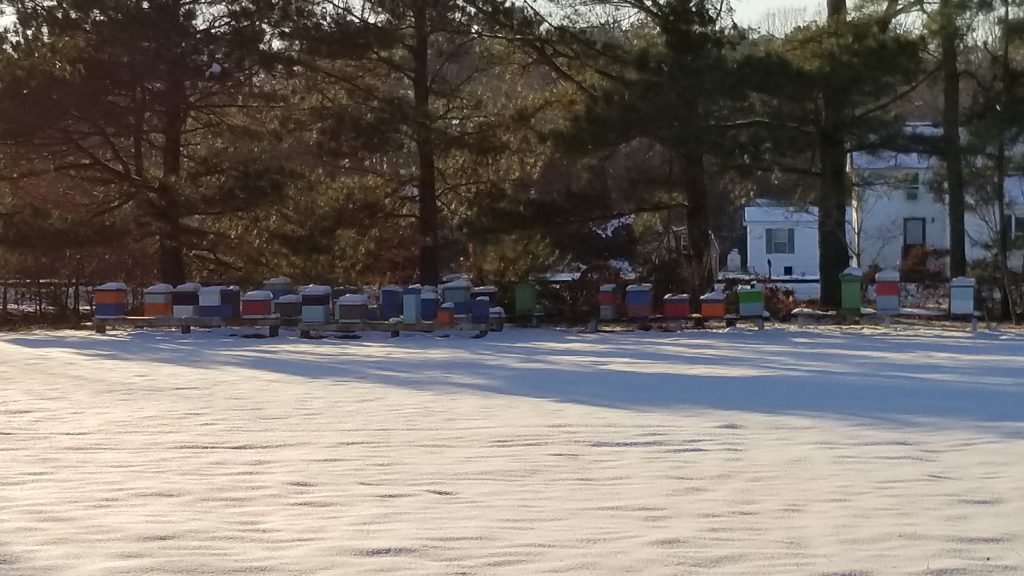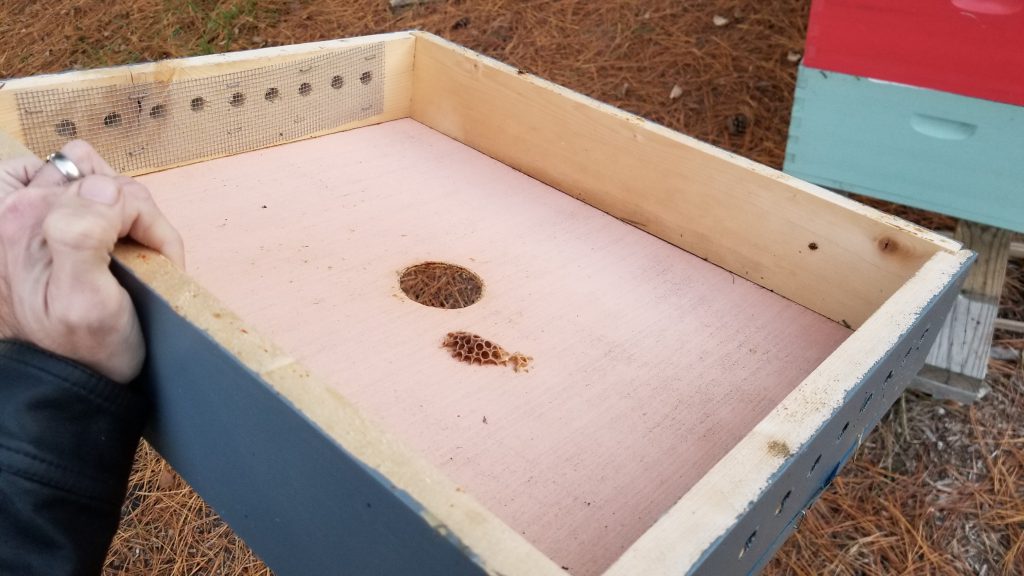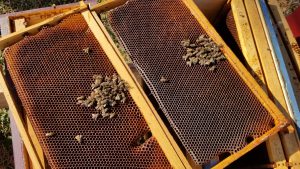This past weekend, I discovered that winter had truly taken its toll on my apiary. Originally I had thought things looked pretty good. One warm day I walked through and saw bees coming and going from almost every hive. At that time, however, it was still too cold to look inside the hives to check on the health of each colony. Once it did finally warm up enough I could look under the lids, I got a rather unpleasant surprise.
At the peak of last summer, I had 50 hives of various strengths and sizes buzzing with life. As a bee removal professional, I collect new colonies throughout the season, so I always have a few stragglers in the fall. Since the fall nectar flow was very disappointing, I had more than a few weak colonies, so I combined and combined to get their numbers up to a reasonable place. By the time winter rolled around and I was done combining colonies, I had 36 winter ready hives.

Winter prep for honeybees isn’t particularly trivial. They need enough honey to get them through the winter months, enough bees to produce the body heat to keep warm, ventilation to allow vapor and moisture to escape the hive instead of condensing and dripping on the bees, extra protection at the entrances to keep unwanted guests out while they’re not guarding like they would be normally and typically something to break the direct wind from beating right on the hive. There are a few other considerations, but those are the big ones. For my hives, I made sure to leave enough honey behind when I did my harvests and feed sugar syrup in the late summer/fall to those that were light on honey, combined colonies with low populations, built and added vivaldi boards to the tops of the hive (filled with pine shavings) to wick moisture off of the hive and allow it to evaporate, added appropriate entrance reducers and my hives are along a treeline that act as a natural wind break. The hives that still looked a little light on honey all received a sheet of fondant under the pine shavings in the vivaldi board as supplemental feed.

This past weekend, temperatures finally creeped up into the 60’s, a place where I feel safe enough to quickly look in a hive for healthy bees and button them up before their brood gets too cold. What I found was very disappointing. Out of the 36 hives that went into winter, only 8 have survived so far. 28 colonies were dead, still in their clusters trying to keep warm. A few things just didn’t make sense to me. Bees typically handle cold very well. They survived the ice age. They’ve got this. Usually, there’s an underlying cause for winter losses such as lack of food stores, varroa mites, or not having enough bees in the hive. None of these hives appeared to have these problems, with the exception of maybe the latter. As I inspected the dead bees, I found that most of them still had several full frames of honey in the hive, many of them died on a frame containing honey. They definitely didn’t starve. I also didn’t see any sign of mite problems. It’s usually fairly obvious when mites win the fight. One thing I did notice was that these clusters were TINY. There were a lot more bees in these hives as they entered the cold season. It appears that they died off at a rather alarming rate, confirmed by the number if dead I saw them pushing out the entrances over the previous weeks, causing the clusters to shrink beyond their ability to keep warm.

I’ve getting a lot of questions about what I could have done to prevent this problem. Things like:
Can’t you insulate the hive?
Sure you can. It’s typically not necessary unless you live in a climate where it will be below zero degrees F for a prolonged period. I’ve never had to insulate hive in my area before. If you do insulate hives, you have to be very careful not to seal them up to the point they can’t breathe (the hive, not the bees). If that moisture can’t escape the hive, it’s bad news for the bees. I believe going forward, I will insulate the hives if I know it will be colder than usual for a prolonged period.
Couldn’t you add some heat like a heat tape or a light bulb?

Absolutely not. I get this question more than any other and I think people believe I’m an idiot when I tell them I won’t do this. Adding heat to beehives can actually cause more harm than good. There are a laundry list of reasons why it can be problematic. Bees have their own time-tested way of dealing with cold. They slow their metabolism so they require less food to survive. Adding heat raises their metabolism, causing them to consume their winter stores too quickly. The bees may also move their cluster away from their food stores and towards the heat source, causing them to starve. There have been some studies done that show small amounts of very controlled heat can help a small, weak cluster, but it’s difficult not to add too much heat, making it hard for the bees to regulate and control that environment. Naturally, you will find beekeepers out there with differing opinions on the matter, but in the mid-Atlantic region of the United States, heating your beehives isn’t a common practice. There is even an commercially available electric “bee heater” that fits between frames that the manufacturer swears keeps your hives stronger over the winter and building up faster in the spring, but I literally don’t know of a single beekeeper who uses them. A five year study was even done by the USDA in Wisconsin using different heating and insulating methods, proving that a well prepared beehive will survive a Wisconsin winter just fine with no added heat. Adding heat was also very expensive and required electric or a hot water system in the apiary, neither of which I have. Insulating them would be a far better option, preventing heat loss and allowing the bees to regulate heat with less work.
So what now? Recover the best I can. As a honeybee removal professional, I typically gain a few colonies each year. That’s not a guarantee, though. Not every feral colony collected is healthy, friendly or strong. I’m still hoping for a productive swarm season that may bring me a few good colonies of bees. Out of the 8 I have remaining, I have a couple that will be ready to split in the spring. Of course, those hives still have to survive the rest of the winter. February can be a nasty month. I can only hope the worst is behind me.
Bring on the spring!
Just found this. Fascinating. How may hives are there now? March 21st.
Three. Only three.
April 3rd Still only three?
Happy birthday in three days, in case I forget or don’t see you. Will be driving on your birthday.
Actually, since it’s 3:30 in the a.m., it’s the 4th and your BD is in two days. I’m going to bed now. Honey’s already there.